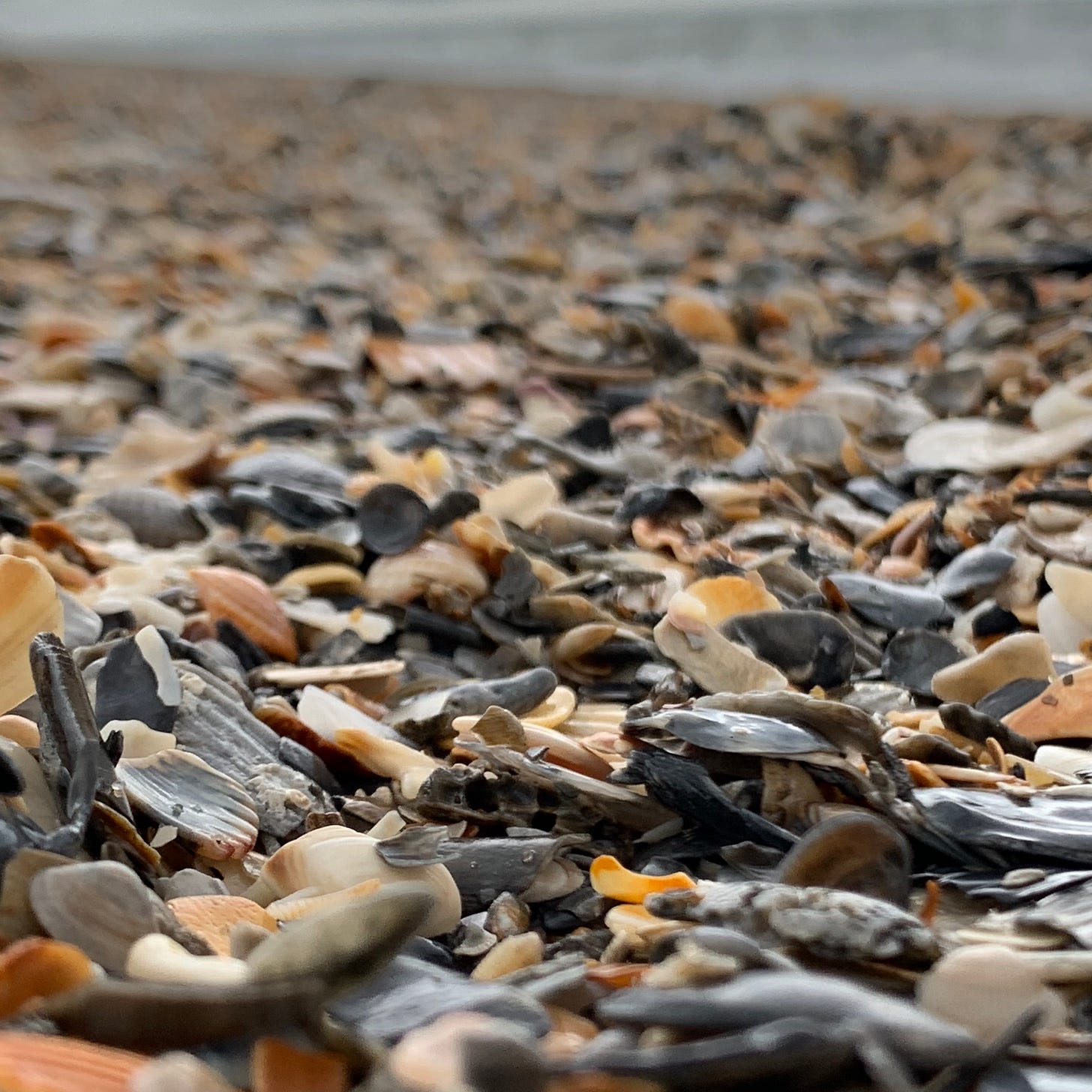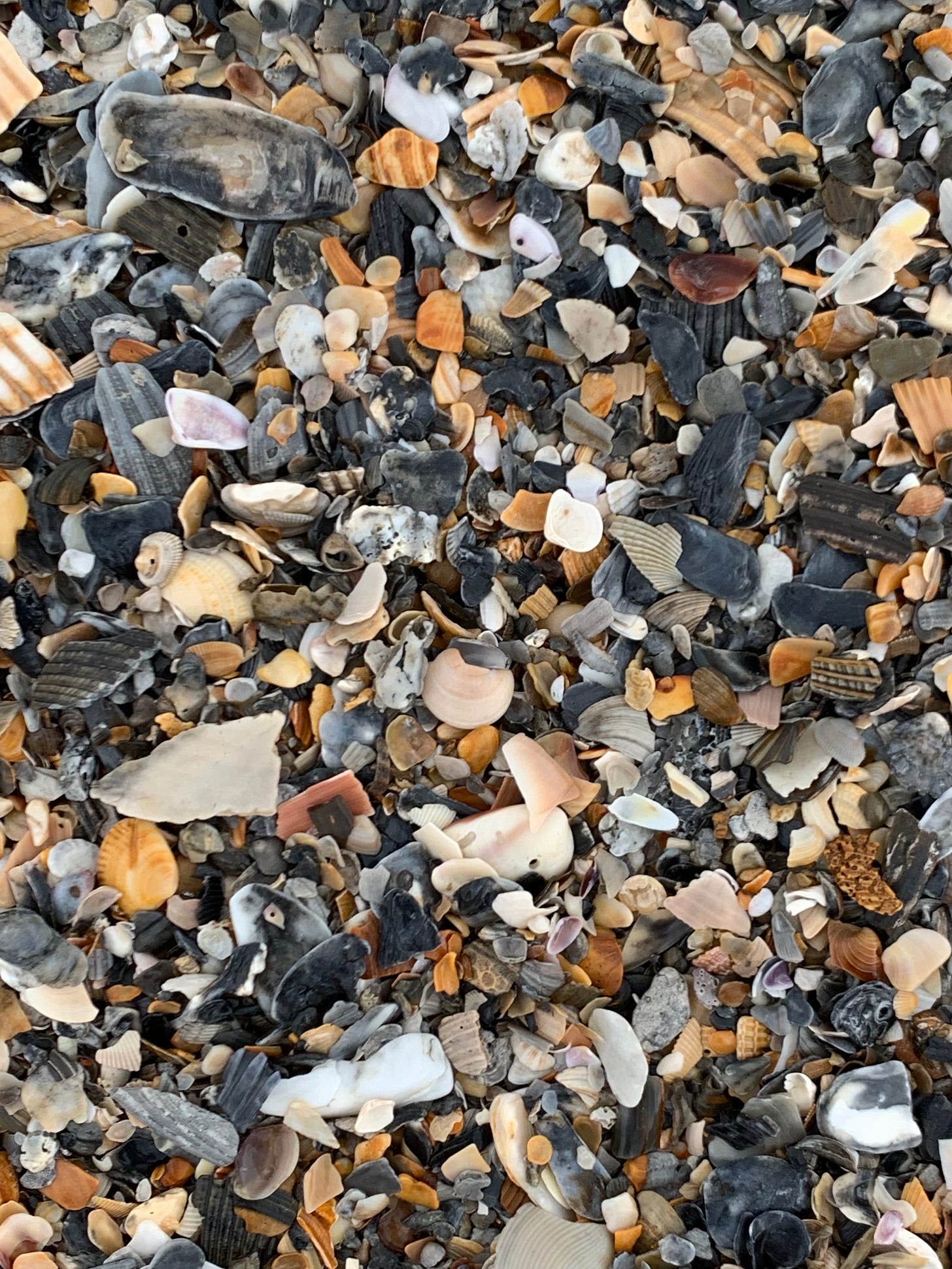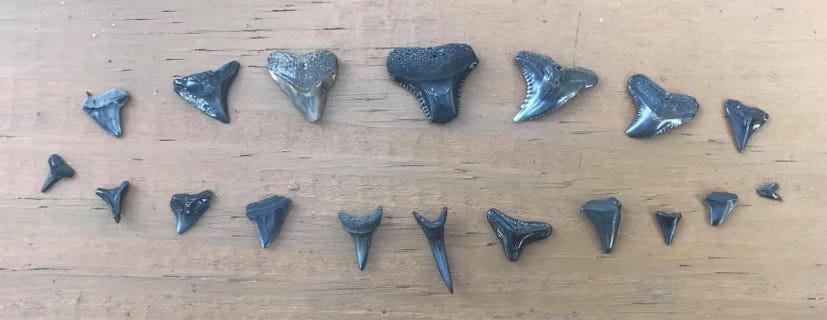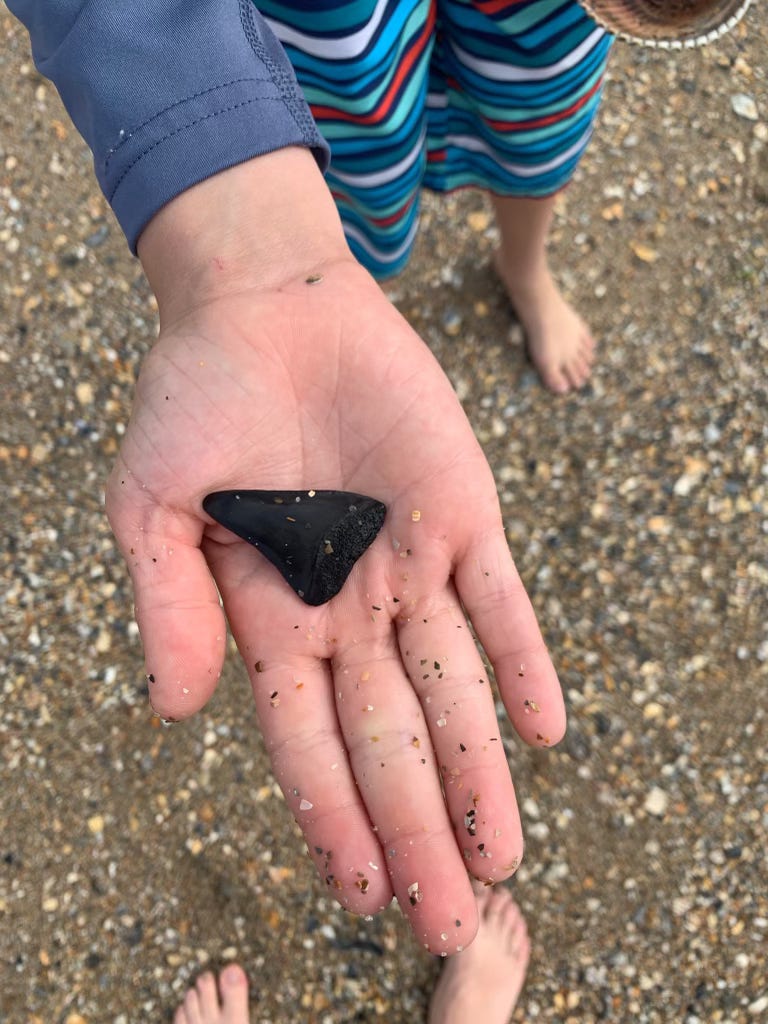Right now I’m with my family and some friends on the coast of North Carolina, about halfway through a ten-day holiday stay by the ocean. It’s one of my favorite places to be, and one of my favorite times to be there. In winter the prices are lower, the crowds are far smaller, and the shore feels wilder, with flocks and flocks of migrating birds, gales and squalls, and spectacular sunsets that aren’t possible in the summer when the sun goes down and comes up over the land. We hadn’t planned to come here this year, but a last-minute deal popped up, so we packed the van and made the road trip.
My favorite beach activity—after simply sitting in a chair by the ocean and doing absolutely nothing—is to look for shark teeth. I discovered that I have a talent for this about a dozen years ago, kind of by accident. Someone mentioned wanting to find a shark tooth, and so I went looking, and quickly discovered that I have a knack for it. As a kid I was always good at finding four-leafed clovers too, so I think I just have the right skill set for it—pretty good vision and an predilection for patterns. People have asked me, over the years, how I find shark teeth, and that’s always my answer—it’s all about patterns. If you think too hard about it, it won’t work; you have to kind of dissociate and pay attention to nothing at all, and to anything that seems out of place.
Here on the beach where we are, layers of broken shells tend to pile up with the sand. It’s different with every tide and dependent on the weather; rougher seas can knock up more shells, but they can also silt everything up with sand so that the shells are buried, too. If the shells are sparse, the shark teeth will be too. But if there are bands of shells laid down near the water line, then conditions might be good for hunting.
The shark teeth here don’t come from living sharks. They’re fossils, often tens of millions of years old. And they don’t come from the seabed like you might expect; the fossil teeth found here (and elsewhere like Florida) are washed down in rivers from further inland. Millions of years ago the shoreline was hundreds of miles further west, in a line that’s now called an escarpment, that stretched down the eastern seaboard. You can still see it today in satellite images, as a subtle change in terrain that runs, on the map below, through the NC, SC, GA, and AL abbreviations on the map. To the south and east of those abbreviations, you’ll see a line where the darker green turns to a sandier beige. That’s the ancient shoreline, and there are roads along it that still, to this day, plunge a few dozen feet in elevation, dropping from the eroded and smoothed-out seaside cliffs from millions of years past.
You can also see this line, strangely enough, in a ghost of this pattern in voting patterns in the United States. The sandier soil that used be ocean floor was superior for agricultural production, which meant that plantations were concentrated there in the 18th and 19th centuries, which meant that slavery flourished there, which still influences demographics today, and therefore voting patterns. History rests on patterns too, and the past is never very far away, no matter how we sometimes wish it were.
Today, rivers flow through those ancient seabeds along the coast of the southeastern United States, and they erode out and wash down whatever is hidden in there, including a lot of fossilized shells. The blackened shells along the coast of North Carolina are that color because they have sat in slow-moving blackwater rivers for thousands of years, being dyed by sediment and silt. By the time they wash out into the ocean, they’re sometimes coal-black. The same is true for shark teeth; the teeth pick up pigmentation from the river water and emerge jet-black at the end of their journey. That’s good news for shark tooth hunting; the darkened teeth stand out against the sand, and if you know how to look for them, they even stand out against the broken shells that are likewise often dyed black.
This is where the patterns come in, and the iterations and repetitions that come from looking at thousands of black objects against the sand. It’s almost algorithmic; I let my eyes pass over huge quantities of beach, usually while at a slow stroll. I try to notice anything out of the ordinary, but especially two things: the degree of darkness, and the curvature of shape. Shark teeth stand out as a purer, glossier black against the surrounding shells, and so you can pick them out by color. And while a lot of shells can be broken into triangular shapes that roughly mimic a shark tooth’s shape, there is a curvature to a tooth that’s pretty unique. The combination of those two things makes it easy to spot a shark tooth once I come upon it. In terms of big, round numbers, I probably pause at about every thousandth object and look more closely. Of those, I probably end up picking up one in ten, and of those one in ten (of ten in a thousand), maybe one of those ten end up being a shark tooth. Ironically, smaller teeth are easier to spot, because their color and shape are easier to perceive at a glance. The larger ones more easily masquerade as shells.
On a good day in the summer, I can find a dozen or so teeth this way. I know others who can find far more than that, so it’s not like I’m a savant or anything. Some friends of ours are famous for finding a couple hundred or more in a one-week vacation, which is amazing. I think my one-week record is in the high 20s or low 30s—and that’s if the weather cooperates the whole time, and low tides are at convenient hours. (High tide is universally pretty crummy for shark teeth). Unfortunately, winter is a hard time for finding shark teeth for a few reasons. First, the ocean is calmer, which leads to fewer shells. Second, the water is too cold to wade through, so you can’t use shallow water to catch aspects of shape and color that you wouldn’t see on dry sand. And most importantly, the light is all wrong. The sun is so far south that the angle of light hitting the shells creates all kinds of triangular, pitch-black shadows, which almost works like camouflage for any teeth that might be hiding there. In several cumulative months of wintertime beach strolling, I think I've found fewer than ten teeth. I still look, because I enjoy the meditative aspects of it, but I’m five days in to this trip and I’ve only found one so far.
One of the greatest joys of the past five or so years is that my kids have gotten into it, especially my oldest kid. The combination of youthful eyesight and eagerness have meant that my own child has already far surpassed my shark-tooth-seeking abilities, and the other two kids aren’t far behind. It’s one of the most rewarding things to do with my kids, even if there’s a little friendly competition involved.
Since looking for shark teeth is such a meditative and dissociative process for me, I spend a lot of time thinking while doing it, and inevitably my thoughts turn to time. It’s hard not to think about the eons that have gone into the shells, the sand, and the teeth—the lives that came and went and left traces for me to sort through and collect. The tides roll in and out and in and out, a constant reminder of the constancy of change, and the sand and water are never the same twice, and never all that different either. It’s another pattern embedded in the world, the in and out dance at the water line, and even the island that I’m walking on, seeming so permanent, has shifted with the sea and the shore. It has existed hundreds of miles away, or not at all, over the years. One day, perhaps not so long from now, this island will move again, or sink under the sea for a few tens of thousands of years, and all traces of it and of me and all of us will go underground for a while, only to be washed out by a river millions of years hence. I find the thought strangely comforting.









